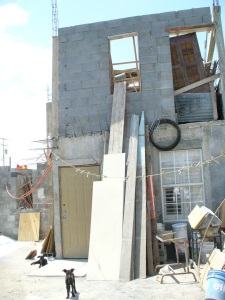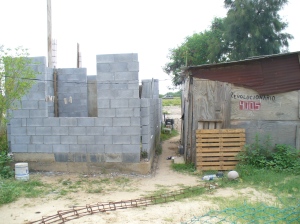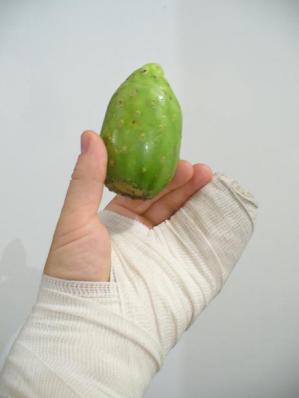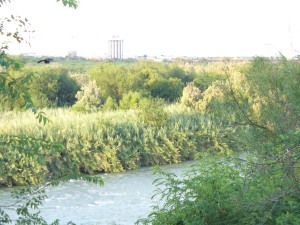I promised a long time ago to write about housing in Nuevo Laredo.
So I will exercise self-control and delay the gratification of writing about my recent outing to a lucha libre pro wrestling extravaganza. I will write instead about how housing gets built here in Nuevo Laredo – more of a sweaty struggle than the lucha libre on any day – and why housing microfinance is important in this process.
Hopefully this post will serve to dispel rumors that all I do here is go fishing, write medical adventure stories, and nearly get arrested (see previous posts).
Visiting Kiva borrowers and writing journals represents a big part of my work for Kiva at my partner organization, FVP (Fundación para la Vivienda Progresiva, or Progressive Housing Foundation). For those of you who not yet gotten addicted to reading them, journals are updates that give a fuller sense of the Kiva client and the impact of the loan. (To check out current journals on the Kiva site click here.) So far I’ve visited over 100 borrowers to interview them for a journal. More than 50% of FVP’s portfolio is in housing loans, so I have spoken to many individuals and families who have borrowed Kiva capital to make housing improvements.
One sure icebreaker in Nuevo Laredo when talking to borrowers is to ask if they built their house all at once.
That usually gets a big laugh – a kind of “you don’t know how things work around here, do you?” laugh.
To understand how housing works in Nuevo Laredo, Mexico (and in a lot of Latin America) requires rewiring (or maybe discarding?) the typical 21st century American conception of how a house gets built. Houses do not just look different here; most of the process that brings them into existence is different from the process by which new houses are born in the U.S. – different in terms of the time it takes, how the capital flows, who maintains control of the process, and many other factors.
My icebreaker usually gets a laugh – or a sneer – because it often takes years for families to build their houses to fit their needs. The relatively low household incomes of FVP clients mean that it takes a long time to gather the capital to make housing improvements. Most families thus make housing improvements in stages, using gradual savings and occasional windfalls to purchase building materials and incrementally build their houses, wall by wall, sometimes block by block.
When you drive through some neighborhoods many of the houses look like construction supply yards, with future building ambitions measured in stacks of concrete block. The same number look like construction projects abandoned at various stages of completion. On one block you can sometimes see houses ranging from a wooden shack up to a two story concrete home with balconies – a textbook graphic of the stages of the housing process in that neighborhood. If you have never been to a developing country, this afternoon drive through one such neighborhood gives a sense of how the housing stock is in a perpetual state of evolution.
Time moves slow on housing improvements because money does not accumulate quickly for most families. Traditional mortgage financing is not an option for most low-income families. Part of the reason is that low-income households simply cannot make the payments that would be necessary to carry even a modest (say $15,000) conventional mortgage. Furthermore, many are self-employed or work informally, making it difficult to prove income even if it were high enough. And the land that they build on often falls short of having full title, so they lack collateral to secure a bank loan. These are only some of the reasons.
Even if these factors were in place for low-income households, most banks are not set up to offer small housing loans and would struggle to break even on small loans. Some government programs have had success in helping low-income families, but are typically only available to workers in the formal sector, i.e. not those who are self-employed or work in informal enterprises. (Probably more than half of FVP clients with Kiva capital fall into the latter categories.)
So households rely on their own wits and resources to build their own housing. This process is called by various names: progressive housing, self-help housing, incremental housing, and informal housing. Variations of this strategy account for the great majority of housing production in the developing world. (By the estimate of one author, Diane Mitlin, upwards of 80% of housing in the developing world is built this way.) The main characteristics of this process are 1) an almost complete lack of involvement on the part of formal institutions (banks, government permitting or inspections, formalized contractors or developers) 2) an incremental approach, building in stages over several years 3) household control over most aspects of the process.
This latter point means that each household, in a sense, becomes a micro housing developer. Each family acquires its own land, buys its own materials, provides its own labor or pays an informal contractor to complete the work. All of these inputs to housing require capital, which the family raises however it can – self-financing, you could call it.
As you might have guessed, the process of building housing in a low-income neighborhood of Nuevo Laredo is not exactly like building a house in, say, the suburbs of New Jersey.
To start, the order of the construction process in neighborhoods built incrementally is almost the opposite of building a new house in the U.S., as this crude comparison shows:
Typical new house in U.S.:
1. Land purchased
2. Installation of services (water, sewer, electric)
3. Paving of roads
4. Construction of home
Typical incrementally built house in low-income neighborhood of Nuevo Laredo:
1. Land purchased
2. Provisional home construction starts
3. Home construction gradually transforms into more permanent materials
4. Installation of services, usually electric and water first, then sewer later if at all.
5. Paving of roads, if at all.
Households acquire land by various means – some by purchase and some by occupation. (Purchase seems to be more the norm in Nuevo Laredo now.) Low-income families usually purchase in relatively unsettled areas on the outskirts of the city, where prices are most affordable. For many if not most families, this is likely the biggest sum of money that they have ever paid for anything in their lives. (The average salary of a factory worker here is about $2,000 dollars a year. I never heard of a plot of land costing less than $1,500 in 2008) Families often buy the land in installments, paying a downpayment to the seller and the paying the rest over several months or even several years.
Other families acquire land through occupation. This is a much longer story that would take another blog. To generalize, it means that a group of families “invades” (that’s the word they use here) a plot of uninhabited land (often owned by the city), typically on the periphery. The city often “regularizes” these settlements once they have grown into neighborhoods, eventually granting some form of legal title to the occupant.

For many families used or found materials build the first house. Those who have invaded land also use this house as a marker to stake their claim.
At this point families are landowners, but that’s about all. It is typically land without services – no electricity, no sewer, no water hookups, definitely no cable or internet. Often they have a bill of sale or some proof of an exchange of ownership, but less frequently have an actual title to the land. This is a longer story of informal land divisions that I will get to in another post if I can.
María, a Kiva client and single mother, is one example of how families persistently and progressively build up their home over time. Her parents acquired the land through occupation about 13 yrs ago, a 7X20 meter (about 23X65 feet) plot in a neighborhood that was basically monte — desert brush — at the time of occupation. Their first step was to build a single room house out of wood. This is a typical of families with limited capital; they often build this first part of the house out of found materials or buy used wood and materials at one of the many pulgas (flea markets) in the city. The variety of materials that you see is impressive: old pallets, sheet metal, big cans pounded flat, old signs, the works. Why is this the first step? Two main reasons: some families can afford to pay rent for a more decent place, but paying rent means not being able to save to build a house. So people build a provisional house, live there, save on rent, and can put away some money to build a “casa de material” – a house of more permanent materials.
In the case of María, after four years of being on the land, the city began to install water lines, followed by electric. After about five years she and her family had saved enough to begin building a second room made of wood. Many families at this point do not yet have the resources to put down a floor, and the roof is often made of makeshift materials like second hand plywood and sheet metal. After this point María began saving up to build the first room of permanent materials..
Three years later María applied for and received her first housing loan from FVP, for $8,000 pesos (about $800 dollars). María combined this loan with her own savings to start building the first structure of new concrete block, a two room house behind the original wooden house. (By this point, she said, the original wooden house was already in bad shape.) María told me it would have probably taken her at least another 1-2 years to put together the money to build this first phase of the concrete block house if she had not received the loan.
At FVP, this is often the point at which housing microfinance enters the scene as a source of funds for these “microdevelopers” of housing i.e. when families are already addressing their housing needs, but need to access capital to move their projects forward more quickly. Not unlike the way that microfinance capital can unlock the potential of microentrepreneurs, housing microfinance helps to loosen the bottleneck of capital that can impede housing improvements.

This family bought a "piece of the desert" 15 years ago, built a small wooden house, which they slowly transformed into a two bedroom house of concrete block, using their own savings and three loans from FVP (the last one was Kiva capital).
Based what I have seen as a Kiva Fellow at FVP, here are some major reasons why I think housing microfinance is a valuable tool in a housing context like Nuevo Laredo:
1. Households are already accustomed to improving their homes in stages, so small loans complement this incremental approach. Having a small loan – in the case of FVP usually between $500 and $2,000 – allows families to move forward with improvements and then pay back the capital at a pace that they can handle. It is a like a miniature home improvement loan, tailored to a strategy of progressive construction.
2. The requirements for the loans are flexible – alternative proofs of land ownership are accepted, and the land itself does not serve as the collateral for the loan. (The guaranty on the loan comes from a friend or family member who serves as a kind of co-signer.) Loan officers understand have learned how to determine the income of self-employed or informal sector employees, recognizing that just because they don’t have paystubs does not mean that they don’t have incomes.
3. This capital allows households to make improvements at a much faster pace. This means that families get to live in healthier, safer, more comfortable conditions sooner than would have been possible without a loan. The potential positive ripple effects, in my view, are numerous.
4. Housing microloans enable households to make improvements that require a large infusion of capital and cannot be completed incrementally. For instance, a family can gradually build four walls for a new house, but you need to pour the concrete roof all at once. Many families use a loan for relatively big ticket items that are hard (or much more expensive) to achieve incrementally. Having more capital also means being able to buy more in bulk, get better prices, and get more brick for your buck, so to speak.
5. A housing loan contributes to the creation of an asset that helps to stabilize the family in the present and into the future: a home. Having a house of one’s own means not having to pay rent – and being able to save for other purposes. This asset is probably the greatest representation of wealth that the family has, and, theoretically, could be sold or serve as collateral for a loan in the future. Even if a weak housing market means that the house does not necessarily have a high exchange value, it has a high use value for families, both in the present and a patrimony for their children.
6. Improvements in housing conditions can have positive economic multiplier effects. Of the businesses I visited (about 50) 75% were located in the home of the entrepreneur, ranging from a tailor to a small grocery store to a tortillería. Many families have told me that they had always thought about starting up their own business, but they were waiting to have their own home to be able to do it. Home improvement loans can thus play a role, direct or indirect, in fostering the conditions to start or to expand home businesses.
To continue with the story of María: after finishing the first phase of the two room house, she continued to save, and just completed the two room house by combining Kiva loan capital (a second loan of $1,000) with these savings. It took thirteen years to go from blank land to a house of permanent materials. The newly-inhabited house looks great, stuccoed smoothly and painted a peach color. Right in front of it stands the bare frame of their original makeshift wooden house, a testament to how far they have come. She now uses the second room made of wood for her hair salon, which she started with her sister a few years ago. She makes enough income from the salon to support herself and her three sons, who play under the wooden structure that was their home when they were toddlers. She is thinking of applying for another loan to put up walls around the rear of her property and a new roof on this original structure, to provide a shady place for her children to play. All of this would have been harder to achieve and much slower, María and other families have told me, without having access to microfinance capital.
Stories like María’s are important because they describe the housing process for a large part of the population in Mexico and the developing world: progressive, incremental, largely informal. The way that houses, neighborhoods, and cities evolve has a lot to do with the way that low-income families build progressively in reaction to a housing market that has not offered them many other options. It is easy to look at the first steps some of these houses – scrabbled together plywood, half-built block walls – and think that they are constructed in a helter-skelter manner. To the contrary, there is, in fact, a system by which people improve their housing and a pattern to their resourcefulness. Housing microfinance can play an important contributing role in this system, serving as a powerful resource for these “micro-developers”. It loosens up the blockage of capital that can prevent improvements from moving forward, clearing the way for families who already know how to be resourceful in addressing their housing needs.















